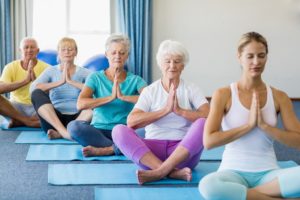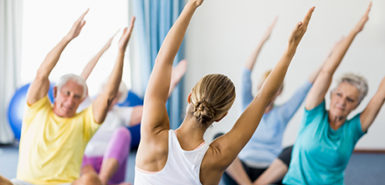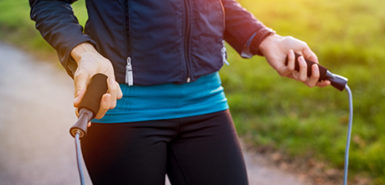
Many people count themselves out of yoga before ever trying a class, thinking, “I’m not flexible enough,” “I have terrible balance,” or, “I’m too old to do that.”
Modified poses and a listen-to-your-body approach allow individuals of any age and ability to participate in yoga, said Denise Karsen, RYT-500, who instructs virtual yoga classes at Corewell Health and Corewell Health’s Lemmen-Holton Cancer Pavilion.
She’s taught students ages 9 to 86, and she encourages students to embrace compassionate awareness and learn to listen to what their body needs.
“Even the most gentle yoga can really progress health,” Karsen said.
The healing benefits can be especially powerful for those facing medical issues that limit mobility.
Someone who has had hip replacement, for example, can engage in gentle stretching with post-surgical healing benefits. Karsen has also seen yoga help patients with cancer regain range of motion and bone mass.
Choose a style
Beginners should keep in mind there are a wide range of yoga styles. Major types include hatha, iyengar, vinyasa, ashtanga and hot yoga.
An aerobic vinyasa class may boost your heart rate, Karsen said. If you’re looking for a more meditative class, ashtanga or hatha styles focus on mindful movement.
If you are experiencing pain or limitations, a power vinyasa or hot yoga probably isn’t the right fit, she said.
Instead, try a practice described as adaptive, gentle, restorative or therapeutic.
“When you’re trying to determine which of the different types of yoga is best for you, remember that there is no right or wrong one—just one that might not be right for you at this moment,” Karsen said.
She suggests reaching out to a teacher or yoga studio in advance to discuss class formats and adaptability.
Karsen teaches Kripalu yoga, a form of hatha yoga that places equal importance on the body, mind and spirit.
This yoga style is suitable for beginners and it can be practiced by anybody regardless of weight, age, size or disabilities, she said.
“It is a nice option for students who want to benefit from an adaptive practice, such as people suffering from arthritis, overweight individuals and seniors,” Karsen said.
This gentle approach allows students to modify poses and practice at their own pace.
“It really is good for all body types, perfectly healthy and for special conditions including (multiple sclerosis), stroke and cancer. A range of students can take benefit from yoga,” she said.
In some exercise classes, students may feel judged by other students or even the teacher, she said. Yoga embraces a different culture.
“There’s no judgment or competition with yoga,” Karsen said.
Adapt poses
A lot of students can’t physically do certain practices in class. A yoga teacher can offer modifications.
“We meet them where they are at,” Karsen said.
The primary tenet of yoga is ahimsa, or non-harming, she said.
“Yoga is not a place to push through, go beyond your edge or ignore your body,” she said. “You don’t need to be a model or turn yourself into a pretzel.”
For example, a sun salutation series of poses contains planks and chaturangas, poses that require strong weight bearing through the arms and shoulders. To modify, students can perform a tabletop or resting child’s pose instead, to add support through the knees and legs.
When a student says, “I can’t touch my toes,” Karsen said she redirects focus to what they can do.
In this case, she instructs the student to bend the knees as much as needed to bring the fingers to the ground. The legs don’t have to be straight in a forward bend.
“It doesn’t matter what your forward bend looks like,” she said.
If standing isn’t feasible, you can use a chair to sit on, or to stabilize yourself while standing. Blocks and straps also offer support in poses.
Access mindful stillness
Yoga isn’t just moving and holding poses. Karsen’s classes—like many yoga classes—also include practices in stillness dedicated to calming the mind.
Much of the health benefit of yoga actually comes from mindful breathing and relaxation practices performed seated or reclined in stillness—practices not affected by movement limitations.
“From its beginning, it was created to focus on healing, having the body, mind and spirit feel the best they can,” Karsen said.
A clearing breath practice, or pranayama, helps people get grounded, Karsen said. It involves present-moment focus on the breath and also oxygenates the body with energizing effects.
Many yoga classes end with a relaxation practice, or savasana, to calm the nervous system and integrate the effects of the whole yoga practice.
Grounding in quiet stillness has health benefits, she said. Yoga nidra, for example, is a guided practice that’s extremely relaxing.
“The main reason they come is to get exercise,” she said. “But many return to relax, reduce stress, get away from the pressures of a high-stress job, relationship or modern life.”
 /a>
/a>
 /a>
/a>
 /a>
/a>